|
|
|
Sort Order |
|
|
|
Items / Page
|
|
|
|
|
|
|
| Srl | Item |
| 1 |
ID:
113249
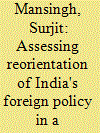

|
|
|
|
|
| Publication |
2010.
|
| Summary/Abstract |
The accelerated pace of globalization in its many facets has benefited some and disadvantaged others. India's foreign policy adjusted well to changes in the external environment by establishing cordial and increasingly substantive relations with the economic dynamos of East Asia, including China, as well as the wealthy countries of the West, especially the United States. Full realization of national objectives is impeded, however, by serious socio-economic problems at home, inadequate staffing or coordination of national security institutions, and the continuing burden of Pakistan's enmity. India's contributions to global management in the years ahead are expected to rise with its capabilities and be welcomed by most other countries as well.
|
|
|
|
|
|
|
|
|
|
|
|
|
|
|
|
| 2 |
ID:
187157
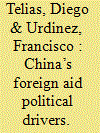

|
|
|
|
|
| Summary/Abstract |
This study investigates a novel dataset comprised of a universe of 537 donations in 33 countries in Latin America and the Caribbean, between 11 February and 20 June 2020, which provides a high level of detail on China’s and Taiwan’s mask diplomacy. We describe who the main donors were, who the main recipients were, what was donated to each country, and which variables explain why some countries received more aid than others. Drawing on previous literature, the article advances understanding about the political determinants of these donations. Our findings revealed that, although seemingly uncoordinated, donations made by China’s central government, Chinese companies, cities, and foundations were strongly affected by two political determinants, namely the recipient’s partnership status with China and the One China Policy. Furthermore, aid provided by China’s Central Government was larger in autocracies than in democracies.
|
|
|
|
|
|
|
|
|
|
|
|
|
|
|
|
| 3 |
ID:
157750


|
|
|
|
|
| Summary/Abstract |
Globalisation has left tremendous impact in the contemporary world. Despite positive aspects of globalisation in many sectors such as rapid communication, business, enhanced interactions among the peoples, it has also introduced some major changes in the economics, political and military domain of world politics. For example, the rise of China, in terms of economy and military power, is one of the most significant events in the age of globalisation. Despite being a communist state, it liberalised its economy to become one of the largest beneficiaries of globalisation. At the same time, the relative decline of the United States (US) appears to be visible in its economic and political status. This paper takes up the case studies of the US-India Nuclear Agreement and Sino- Pakistan Nuclear Cooperation to demonstrate the political as well as military polarisation of the world and how it is being affected by globalisation. The US and India developed their bilateral political and strategic relationship to a great extent after 9/11. India cooperated with the US in the Global War on Terrorism (GWoT) while the US came forward in signing a nuclear pact with India in 2008. The most common factor seems to be balancing China– the emerging dragon. On the contrary, China and Pakistan enhanced their nuclear cooperation mostly to counterbalance the former. One of their prime objectives is India, a common rival of Pakistan and China, since India – the emerging elephant – is also growing very rapidly, second only to China. Both case studies reveal that the nuclear cooperation and strategic partnerships are triggered by their intentions to safeguard the benefits accrued from globalisation.
|
|
|
|
|
|
|
|
|
|
|
|
|
|
|
|
| 4 |
ID:
187210


|
|
|
|
|
| Summary/Abstract |
A reassessment the nature of “alliances” and “alignments” since the end of the Cold War, both practically and conceptually, is long overdue. Treaty alliances have become partially obsolescent as new models of security cooperation, such as the ‘strategic partnership’, and other “minilateral” configurations, have emerged as preferred instruments of alignment. The evolving nature of alliance and alignment is nowhere better illustrated than in the metamorphosis of the venerable Hub-and-Spokes US alliance system in the Indo-Pacific. This article captures the changes occurring in the US alliance system from both a macro-level (structural) standpoint, before proceeding to the micro-level to evaluate individual alliance/partnership dyads to illustrate the complexion of the hub-and-spokes “plus” configuration of today. It argues that we are witnessing is a “reshuffling of the deck” in terms of traditional treaty allies – with Japan and Australia now forming the “core” of the system, with South Korea effectively confined as a “single-issue” alliance focused on the peninsula, and with Thailand and the Philippines (arguably) becoming increasingly “peripheral”. But even as the original treaty-system contracts, Washington is seeking to “network” the original model through the acquisition of non-treaty strategic partnerships with key states such as India, Singapore, (and, more circumspectly – Taiwan), whilst also welcoming European engagement. This networking strategy is also designed to achieve second and third order effects through incentivisation of direct “spoke-to-spoke” security cooperation and through the concentration of allies/partners into minilateral formations. The resultant reconfiguration might be dubbed a Hub-and-Spokes “plus” model.
|
|
|
|
|
|
|
|
|
|
|
|
|
|
|
|
| 5 |
ID:
141993
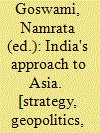

|
|
|
|
|
| Publication |
New Delhi, Pentagon Press, 2016.
|
| Description |
xii, 524p.hbk
|
| Standard Number |
9788182748705
|
|
|
|
|
|
|
|
|
|
|
|
Copies: C:2/I:0,R:0,Q:0
Circulation
| Accession# | Call# | Current Location | Status | Policy | Location |
| 058382 | 327.10154/GOS 058382 | Main | On Shelf | General | |
| 058383 | 327.10154/GOS 058383 | Main | On Shelf | General | |
|
|
|
|
| 6 |
ID:
096015
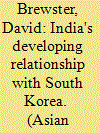

|
|
|
|
|
| Publication |
2010.
|
| Summary/Abstract |
The long-standing strategic disconnect between South Asia and the Korean Peninsula is breaking down. Driven by the changing balance of power in Asia, India and South Korea have developed a strong economic partnership, and taken small but significant steps toward a political and security relationship that refects their numerous shared strategic interests. This article explores the contours of this evolving relationship.
|
|
|
|
|
|
|
|
|
|
|
|
|
|
|
|
| 7 |
ID:
101963
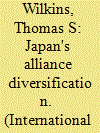

|
|
|
|
|
| Publication |
2011.
|
| Summary/Abstract |
As part of its movement toward 'normal country' status, Japan has begun to engage in a policy of alliance/alignment restructuring and diversification. This is a twin-track policy - the reconfiguration of existing allied relationships and the creation of new cooperative bilateral links. In recent years, Tokyo has deepened its ties with the United States and Australia on the one hand, while cultivating new partners such as India, as well as several Southeast Asian states. This article examines the nature and dynamics of two of the most important new strategic partnerships: India and Australia. Through a comparative analysis, it seeks to account for their formation, structure, and prospects using a specifically designed model of 'strategic partnership' drawn from Organizational Theories literature. It concludes that these strategic partnerships represent a major platform of a more robust and comprehensive security policy on the part of Japan, forged in response to a shifting international environment in the Asia-Pacific region.
|
|
|
|
|
|
|
|
|
|
|
|
|
|
|
|
| 8 |
ID:
192161


|
|
|
|
|
| Summary/Abstract |
As clean energy policy becomes a pressing need in the wake of the looming climate crisis, the world—especially developing Asia—has witnessed a conflicting trend throughout the 2010s, that is, the boom of coal-fired power development. This article argues that the geoeconomic significance, driven by not only China’s but also Japan and South Korea’s pursuit of national interests, intensified a competition among them in supporting overseas coal fired power financing and has contributed to this phenomenon. Using a mix of qualitative and quantitative data, it illustrates that while coal power financing becomes a conduit for these three ‘developmental states’ to forge comprehensive relations with countries they deem strategically important, the effectiveness of using this conduit is contingent, and constrained by exogenous factors, particularly dynamics of global energy markets.
|
|
|
|
|
|
|
|
|
|
|
|
|
|
|
|
| 9 |
ID:
097405


|
|
|
|
|
| Publication |
Oxon, Routledge, 2010.
|
| Description |
255p.
|
| Standard Number |
9780415777759
|
|
|
|
|
|
|
|
|
|
|
|
Copies: C:1/I:0,R:0,Q:0
Circulation
| Accession# | Call# | Current Location | Status | Policy | Location |
| 055052 | 327.5/NAD 055052 | Main | On Shelf | General | |
|
|
|
|
| 10 |
ID:
135235


|
|
|
|
|
| Summary/Abstract |
This article analyses the disunity among African states in terms of United Nations Security Council (UNSC) reform, and attributes it to the contest between South Africa and Nigeria. These two countries have been locked in a hegemonic contest for continental domination. To this end, the article notes that African unity, not in terms of protocol but on the basis of principles and cooperation, is sacrosanct in order for the African Union to make a significant contribution to the reform of the UNSC. It is asserted that the contest between South Africa and Nigeria has been symbolised by the continental leadership aspirations of the heads of state of both countries, and recommends that it be tamed through forging diplomatic and strategic partnerships between the ruling parties of these two countries. The influence of external actors on the African countries, particularly that of France, is underscored as a contributing factor in stalling the debate on the UNSC reform. It recommends that South Africa use its strategic partnership within the association of Brazil, Russia, India, China and South Africa (BRICS), particularly Russia and China as permanent members of the UNSC, to influence the realisation of the reform debate.
|
|
|
|
|
|
|
|
|
|
|
|
|
|
|
|
| 11 |
ID:
153548


|
|
|
|
|
| Summary/Abstract |
Despite the axiom that actions speak louder than words, we care just as much about the latter as we do the former. Apparently, it matters whether we opt for “Burma” or “Myanmar,” “Republic of Macedonia” or “Former Yugoslav Republic of Macedonia” (FYROM), and even whether a consultative mechanism is called a Strategic Economic Dialogue or a Strategic and Economic Dialogue.2 Similarly, it matters what labels or nomenclature states adopt for each other: rivals, allies, or friends. One specific debate that has attracted a fair amount of attention is the language of strategic partners—what they mean (if anything) and with whom the relations have been forged. Yet, there is no definitive answer about how we should interpret the lexicography of strategic partnerships; a statement that...
|
|
|
|
|
|
|
|
|
|
|
|
|
|
|
|
|
|
|
|
|